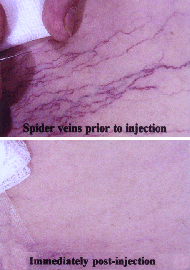Thread Veins and Microsclerotherapy
Microsclerotherapy is a technique used for the removal of surface and spider veins. It involves injections with a very fine needle of a sclerosing solution which has an irritant effect on the lining of the veins causing the walls of the veins to stick together. Blood stops flowing through the veins, which are then absorbed by the body’s natural defence mechanisms over a period of three months. The blood is then directed back to the deeper venous system.
The procedures are carried out by specialist nurses under the supervision of experienced vascular surgeons who are ultimately responsible for the treatments.
Bruising can last anything from two weeks to three months depending on the size of the blood vessels treated. Due to bruising following injections the treated areas can look worse before they improve and it is necessary to be patient to obtain a good result. Occasionally thicker bruises in larger veins, which can remain for several months, may cause brown discolouration of the skin. This could take up to a year to fade. High compression stockings are worn for up to three days to help reduce the amount of bruising. It is usually advisable to leave a two week period between treatments on the same area to allow bruising to settle.
Certain areas are more susceptible to swelling, particularly the ankle and knee areas. It is also possible for some larger veins to develop a small degree of thrombophlebitis were the vessel can feel hard, warm and a little sore. These symptoms resolve spontaneously and simple analgesia may be required. Larger veins may require strong compression for a little longer to help minimise this problem..
Fifty percent of vessels treated at any one session usually disappear. Most or all veins treated during the course of microsclerotherapy can be expected to be eradicated. Unfortunately there are always a few exceptions. In a very small proportion of patients, veins are much more resisitant than normal. We have developed some special techniques to manage this problem.
It is possible to drive immediately after a treatment and we encourage normal activity after treatment. Normal exercise can be resumed after 24 hours, including swimming. Air travel may be undertaken straight away but it is advisable to drink plenty of water and to wear class 2 medical compression stockings on journeys over four hours. Patients find that over time a few more thread veins may appear and it is common for an annual or bi-annual ‘tidy-up’ visit.
Thread veins, or dermal flares, are very fine dilated veins situated just beneath the surface of the skin. Heredity, as with larger varicose veins , is an influencing factor as are hormonal surges as at the onset of periods and during pregnancy. In some patients they are associated with varicose veins but in other people they occur without any problems associated with their deeper veins. It is essential that patients with dermal flares undergo a venous assessment to make sure that there is no underlying condition causing them. Treating surface veins in the presence of varicose veins, even though they are not visible, results in them not disappearing or returning quickly giving an unsatisfactory result.
Mild to severe pain can be associated with dermal flares as well as fatigue, aching and throbbing. This can quite often be cyclical in women and related to their periods. Such symptoms that present with larger varicose veins do not always disappear following surgery but do diminish with subsequent sclerotherapy treatment for thread veins. The best form of treatment for these small veins is microsclerotherapy. Some doctors use lasers to treat thread veins, but experts in vein problems find that these are not very effective in comparison to injection treatment.
Advertisements promoting creams and other methods of treating thread veins often appear in the press. Scientific evidence shows that these do not work at all!
Thread veins






